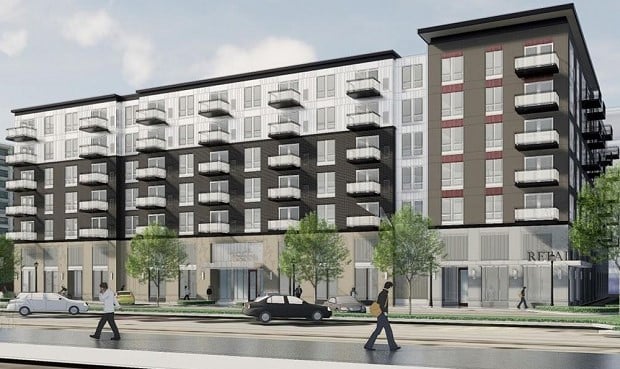 Located at 1555 Ellinwood in Des Plaines, Opus Group’s new transit-oriented development is the type of project most in demand these days. will feature 1,400 square feet of ground floor retail space.
Located at 1555 Ellinwood in Des Plaines, Opus Group’s new transit-oriented development is the type of project most in demand these days. will feature 1,400 square feet of ground floor retail space.
CHICAGO—A quickening pace of job growth this year has fueled new household formation in Chicago and helped sustain apartment demand. But after several years of robust new construction, neighborhoods in and around the urban core do have elevated levels of supply, and owners have begun working a little harder to fill units.
“The numbers say the units are being absorbed,” Kyle A. Stengle, senior vice president, investments, at Marcus & Millichap, tells GlobeSt.com. But landlords, especially those of downtown buildings, increased their use of incentives to keep leasing stable. In some ways, the Chicago market has separated into two major groups, and in the submarkets outside downtown, the many new mid-rise buildings are “leasing up at really robust rates and with minimal concessions.”
Stengle points out that there is a lot of new construction around places like Wrigley Field in Lakeview and in neighborhoods all along the train lines that radiate from downtown. “The farther south you get, there is this feeling that this has leveled out.”
M&M just released its latest report on the region’s multifamily market. Researchers say average apartment rents in the city ticked down slightly during the past 12 months to $1,834 per month. In the prior year, a 5% increase was registered.
Still, the overall picture looks bright. Employers added 41,200 positions during the 12-month period ending in June, and roughly 32,000 of these jobs were created during the first half of this year.
New development was mostly concentrated in the urban core, according to M&M. Builders in the city finished nearly 5,500 apartments during the past year, with roughly 3,000 delivered In the Streeterville/River North submarket, an area with easy and quick access to downtown jobs. Net absorption of more than 4,300 rentals did not outpace completions, and pushed vacancy up 50 bps to 6.0% in the second quarter.
Construction was slower in the suburbs, but might be picking up. In the past year, 2,700 apartments were completed, and developers have about 4,000 currently underway. Suburban vacancy did rise 40 bps in the prior four quarters but at 4.9%, remains quite low.
Although suburban properties don’t garner the attention given to many spectacular downtown projects, Stengle says many investors sense opportunities. The demand for apartments is strong, yields are higher than in the urban core, and even though suburban rents climbed 3.6% during the year to $1,228 per month, many believe these rates will go even higher.
He adds that, like the city, there are vast differences within the suburban market. Many areas see little growth, and a lack of blue collar or workforce housing is a major problem. But suburban downtowns near train lines, including Downers Grove, Des Plaines, Park Ridge and Arlington Heights, among others, are getting much of the development, rent growth and absorption.
And proximity to Chicago’s job engine is the key. “The closer you get to the city,” Stengle says, “the greater the demand.”

















 Copyright © 2024 ALM Global, LLC. All Rights Reserved.
Copyright © 2024 ALM Global, LLC. All Rights Reserved.